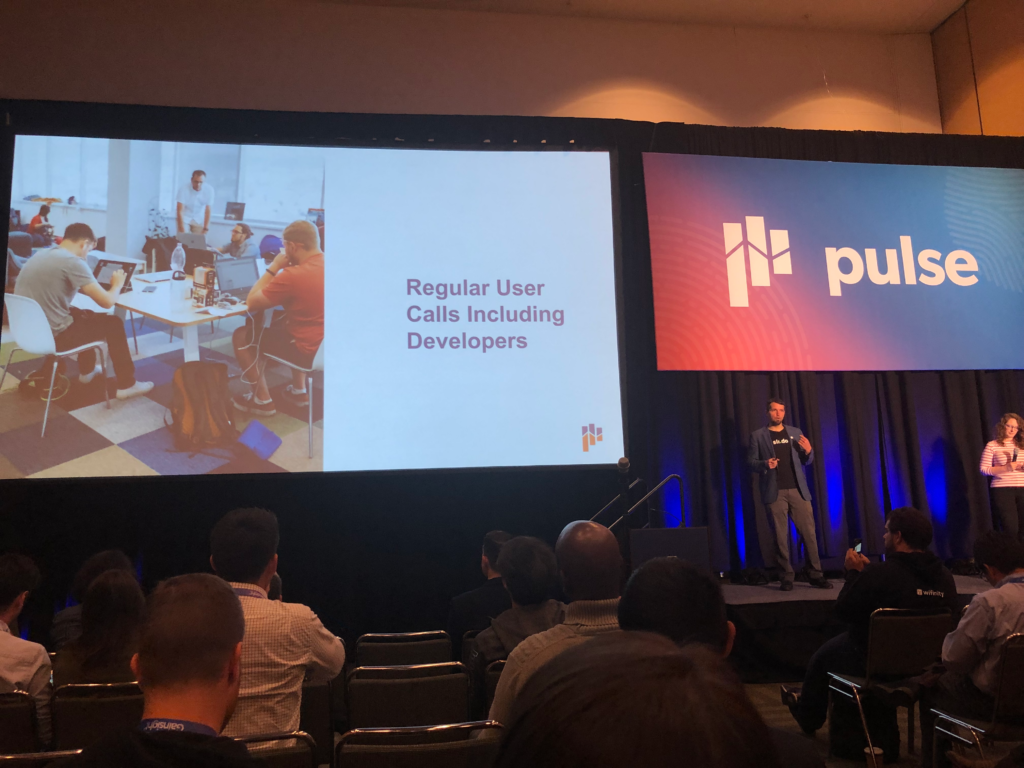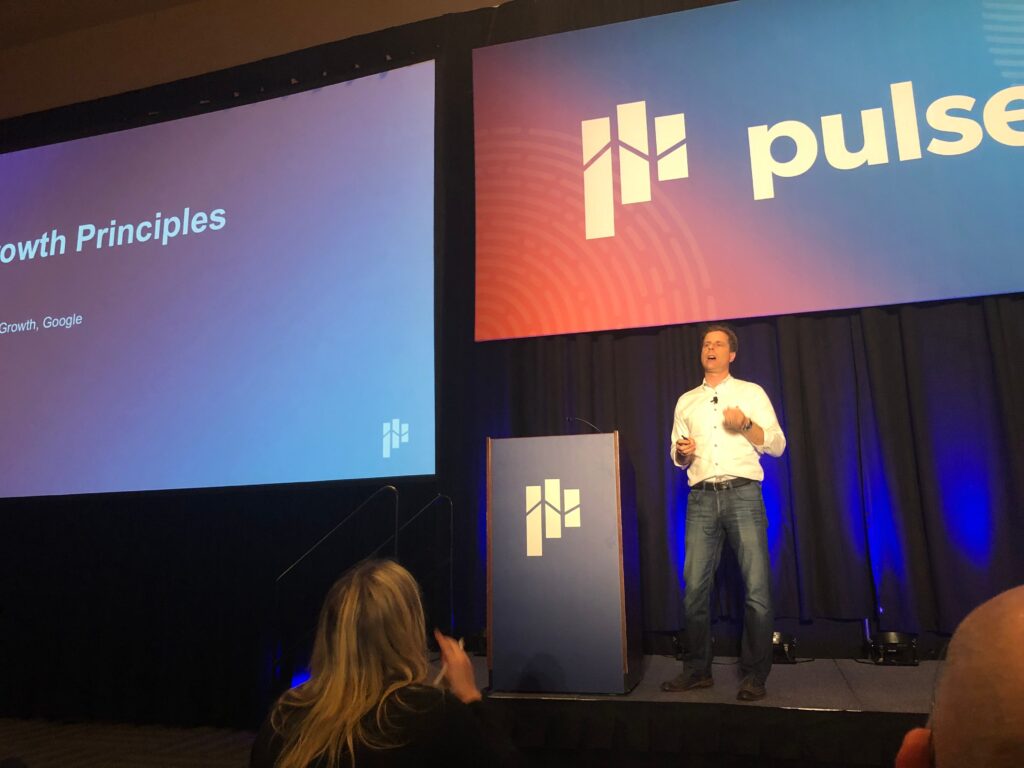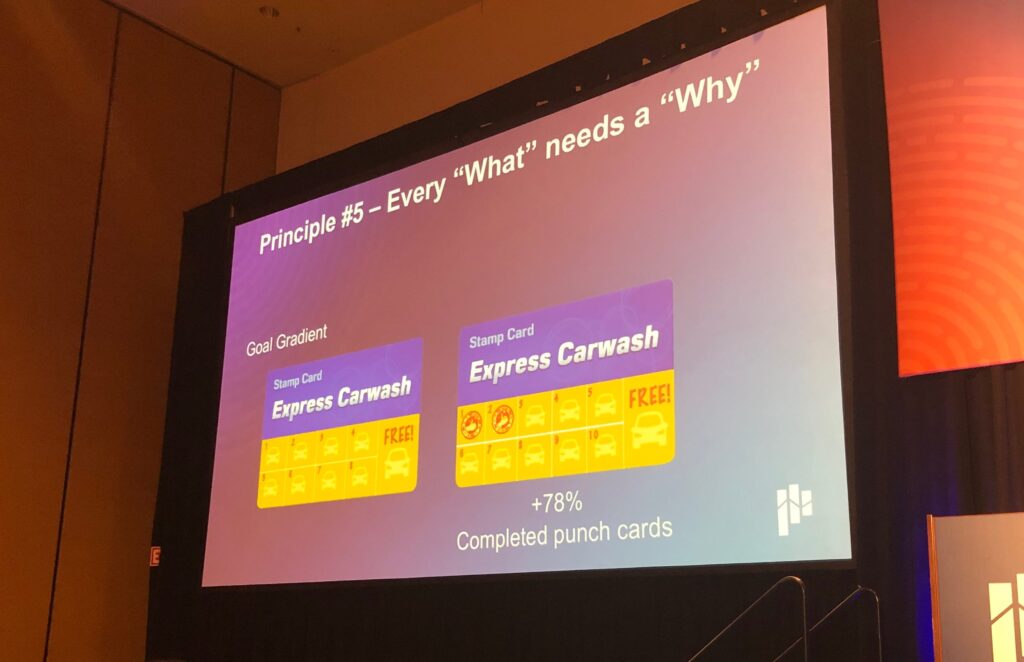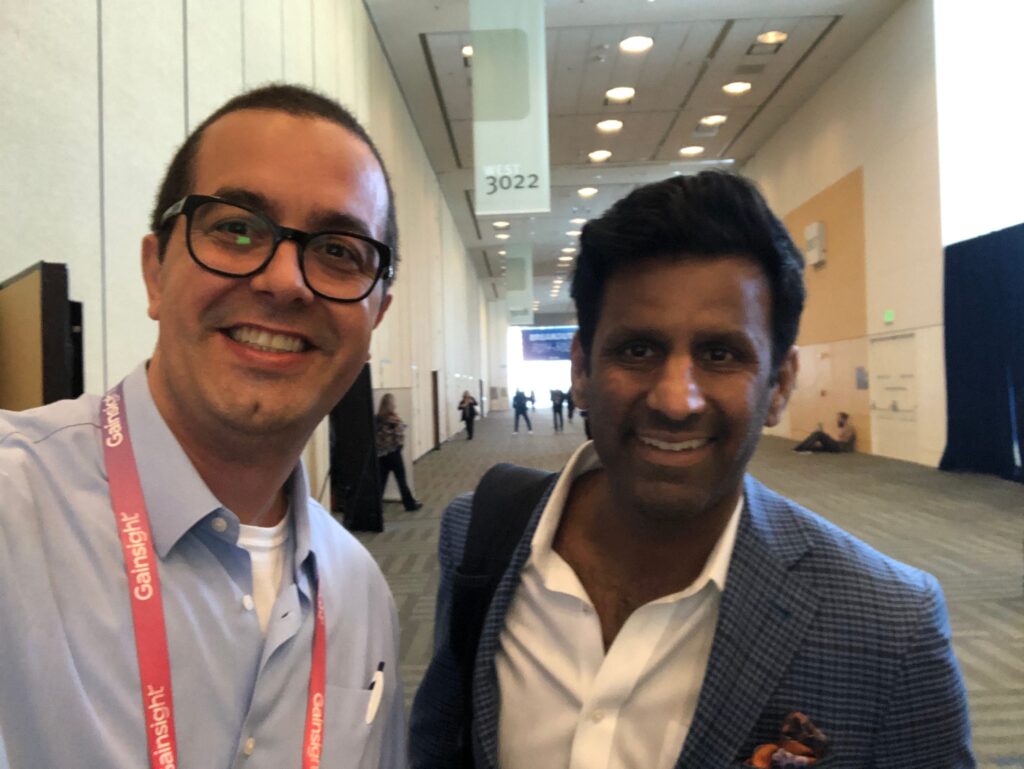The home of the product experience. This was the Pulse 2019 call.
And for being a designer and acting directly with product, it caught my attention. Especially because I work directly with the concept of product-led growth since the beginning of 2018.
Today I see that the investment I made in terms of flight tickets, lodging and everything that participation in such an event needs, especially for those who live so far (37 hours of travel), worth every penny.
There were 3 days of immersion that were worth as a course or a specialization. It is an investment in education that every design professional or product worker should perform at least once a year.
The event took place May 21–24, 2019 at the Moscone Center in San Francisco. Namely, the Moscone is the largest event center in the city, where approximately 5000 people were received. This was, according to the organizers, the largest edition of the event and probably the most luxurious.

With Guilherme Lopes, Co-Founder and Head Product Growth Resultados Digitais.
I summarized the catch-ups and insights of the main keynotes. For a 3-day event that I participated, it would obviously be practically impossible to summarize everything here. What I did then was a clipping and I edited what I really believe can help solve the problems that are on the agenda.
A lot will be left out — and it breaks my heart. But patience, an important part of my job is making decisions. So I decided to show what really caught my eye.
But why a designer in a Customer Success event?
Product Experience is Customer Experience
Product experience takes center stage.
Especially SaaS companies, the Customer Success team helps many companies engage and lead customers to adoption. However, this feature is somewhat limited. It is not possible to scale personalized attention to customers who want to experiment or simply have the first contact with the product.
In this context the experience in the product takes center stage. It is precisely at this point that the event converges to one of the basic pillars of the Product-Led Growth concept, that is, the product becomes prominent. So much so that the first item addressed at the conference is precisely the importance of Product and Customer Success teams working together.
If on one hand the CS team works directly in contact with the customer, raising the main points of pain and improvement needed, on the other we have the product team that has the ability to provide solutions in an efficient and scalable way for the company.
The alignment of these vectors results in the improvement of the product made based on real data and pain of the clients, making a connection with the next point that is related to the evolution of the concept of Customer-First, that is, the human vision of the client.
Human-First Leadership
Do whatever it takes to create a better experience within your product. The concept of Human-First works hard with the issue of building a vision of community, of integration. It was very interesting that one of the speakers (Allison Pickens, COO Gainsight) spoke especially about the importance of preserving our human characteristics and how we need to make the right balance of our day-to-day activities.
Especially in a high-productivity, high-demand market, addressing these issues sounds like a taboo break. And it really is necessary because we need to realize ourselves as human beings that we are, full of failures and needs.
The first step is to understand and respect ourselves as a person. Take time to study, to work, to rest, to take some time off from technology. She even mentioned an example of going to a weekend in a country house with no electricity or internet and how important it is to replenish our energies.
The second point is to note that our client is also a human being. In practice there is no relationship between companies, but a human relationship between people. And that these people’s decisions are based on emotions, much more than logic. In fact, 80% of our decisions are driven by emotions, we use some 20% logic just to justify the decisions that have been emotionally made.
Being alive is proof that you can win in business by putting the human being first.
The 5 Principles for Creating Human-First Products
Every human is in search or would like to be treated within these values. To create Human-First products it is necessary to follow these principles and put them into practice.
Humans Seek Growth: Understand that all humans are in search or growing. It is part of our nature to pursue an evolutionary scale. Support them as they move toward your future. Treat them with respect and become part of their journey yours.
Human beings are special: What is special about humans is our humanity. As humans, we can think and articulate thoughts, we also have a sense of right and wrong, which means our consciousness. Seek the customization and customization of each individual who wishes to make a positive mark on this planet. Treat everyone kindly — not because they are kind, but because you are.
Vulnerability: We are vulnerable beings, capable of making mistakes and of suffering special deficiencies (temporary or permanent), diseases and limitations imposed by the stages of human life. There are also social, political and environmental determinants: for example, culture, economy, power relations, natural disasters. Not just us but also our customers.Understanding and respecting this is a fundamental part of this process.
Treat humans as ends, not as means: Humans should be treated as ‘ends’ and not as ‘means’. Act in such a way that you treat humanity, whether in your own person or in the person of any other, never merely as a means to an end, but always at the same time as an end.
Autonomous Beings: Respect for people is the concept that all people deserve the right to fully exercise their autonomy. An autonomous person is defined as an individual who is able to self-legislate and is able to make judgments and actions based on their particular set of values, preferences and beliefs.
It seems easier to talk than to do, but these concepts are critical to building products based on the Human-First vision.
There are some words that are repeated sometimes like respect , gentleness , autonomy.
If you could give a hint to put these principles into practice, you would follow these concepts as slogans in your next decision-making.
Before we are customers, we are people. We are human beings.
Best Product Experience Through Empathy
In this session, Andy Mcmillian, CEO of User Testing , showed how product teams can combine Big Data with human perception to bring empathy to the customer’s current digital experience.
McMillian said that companies with superior customer experience consistently outperform and perform better than others. According to a Forrester survey (2018 Customer Service Trends: How Operations Become Faster, Cheaper — And Yet, More Human) that point to CX trends, the rate of return of customers to companies that perform outside the curve is extremely high. Once again the word consistency appearing as a key factor for business success.
Another issue is that consumer expectations are harder to meet. Companies should think beyond channels — and in addition to just switching conversations to digital channels. They should focus on providing the best experience based on the type of context and query, including via chatbots, visual engagement, and voice interfaces.
First of all companies need to admit that there is a problem. While 75% of organizations believe that they themselves are user-centered, only 30% of customers believe this is the case. According to Capgemini’s study, this gap between what companies believe and what actually delivery to their customers is what the CEO of User Testing calls the “empathy gap.”
Tips for Building Customer Empathy:
- Everyone needs to be able to see, listen and feel as in fact the customer experience: it is often digital.
Use technology to scale solutions. - Overcome what he called the development team’s curse of knowledge (when he thinks he knows what the user needs / wants).
- Measure the hours of exposure to the customer, especially in functions that are not customer oriented by nature.

Good inventors and designers understand their customers deeply. They spend tremendous energy developing that intuition. They study and understand many anecdotes rather than just the ones you’ll find in surveys. They live with the design.
Jeff Bezos, Founder and CEO Amazon.
The 3 Inconvenient Truths About Leading Human-First Vision
In this talk, Chris MacNamara shared his experience as a leader and manager in the role of VP of Customer Sucess at Glassdoor — a site where current and former employees anonymously analyze companies and their management.
The perception that employees have about culture and leadership matters. Is very. Putting it in an order of magnitude, first and foremost what matters is the seniority of its leaders, followed by the company’s culture and the third quadrant financial compensation.
According to research by MacNamara, 65% of participants identified that respectful treatment by all employees is the primary unit of job satisfaction.
Human-first may not be the same thing Customer-First. On the contrary, as much as it sounds like a game of words, they are completely different concepts and prerogatives. It is important to correctly interpret these concepts in order to put them into practice. Watch out for the hype.
Human-first may not be speed first. Steering is more important than speed.It is better to be going in the right direction with things that you truly believe and that are aligned with your principles than trying to achieve results in the short term.
Human-first may not be comfort first. Making decisions is not an easy process, especially when it is necessary to make decisions that are seen as unpopular. The best way to get your team members engaged is to be transparent and open the reasons why they made such a decision. Reasons are the key to understanding.
Key lessons from Chris MacNamara:
- Your decisions as a leader directly influence the culture and engagement of the company’s employees.
- Human-first may not be customer first, speed first or comfort first. Human-first, very often, is feeling first (based on feelings).
- Human-first means you do not always agree — but the reasons are the key to understanding.
- Transparency over constraints build trust.
- Transparency over mistakes build the culture of accountability.
Customer-centric product innovation — How the Slido product team reinvented itself with deep collaboration from the Customer Success team
The case of Slido is very interesting. It is a very intuitive and easy to use tool and is used at the end of each Pulse talk as a question and answer window. At the end of each talk the audience could ask questions to the speakers directly through the application. These questions were quickly approved by a moderator and

Slido in action: The audience asks the questions in real time and they already appear on the panel.
According to Peter Komorkik CEO of Slido and Jo Massie, VP of Customer Success, 1 year ago (2018) Slido was totally focused on user retention. In order to reach their retention goals, they tried everything to move the pointer: onboarding, surveys, data, processes, customer education, etc. Nothing gave a very expressive result. To really make a difference, they had to change things on the product side.
In order to reach their retention goals, they tried everything to move the pointer. To really make a difference, they had to change things on the product side.
First because the product team was just running a roadmap. The Customer Success team had the feeling that their voice did not matter to others, even though it was on the front line with the customer. In a few weeks after starting the quarter, no one else in the company believed in the product roadmap.

Developers regularly participate in interviews with users of the product.
They have created a team called Customer Experience Team, or customer experience team. In practice they connected the engineering team and the customer success team to work together, attacking the major pains, and solving real customer issues.
Product Side Changes:
- Abolished product roadmap
- They have created truly autonomous teams
- They defined a clear product strategy (and simple)
- They identified the main problems
- They put the customer sucess team inside the product
Change of mindset in the Customer Success team:
- Embrace the pain of the user as an opportunity to learn and improve;
- Do not solve the problem just for one user, try to solve for the next 1000;
- Repeat the pain / insight (critical frequency for product teams);
- See the product team as an ally;
The first results for Slido:
- It’s a big change. The first results will take some time to appear;
- They achieved 20% improvement in the activation of new users;
- Many Q1 roadmap ideas have not survived the Discovery phase;
- The biggest things we did came from the conversations with the users;

The best products are built from the intersection between engineering and customer success.
Customer insights are the lifeblood of user-centric product innovation. To keep insights flowing, you need to continuously demonstrate your impact on the product.
Slido was one of the best cases presented in my vision, especially by reinforcing the importance of teamwork as we continually keep the conversation process with clients.
The 5 Principles behind Google’s Product-Led Growth
Product growth is often thought to be driven by smart growth hacks or the delivery of functionality that is always promised in the next product launch.

Ken Rudin, Mr. Director of User Growth at Google.
But companies that dominate providing consistent product growth take a different approach. They have identified a core set of product principles that drive growth reliably, and the continued application of these principles is at the heart of their product growth strategy.
In this talk, Ken Rudin, Mr. Director of User Growth at Google, addressed some of the key growth principles that help Google deliver consistent, reliable product growth.
Principle 1 — Get the first right mile. Focus on activating users on your product, not just onboarding.
Principle 2 — Growth is a game of inches. Focus on multiple small victories in return for a great single win.
Principle 3 — Increase product discovery. Gradual progression in awareness of available resources. Do not show everything at once. Add more entry points.Promote features in a contextualized way.
Principle 4 — Focus on your worst users, not your best. Focus on marginal users, not the most powerful ones. Growth is often driven by churn reduction versus increased acquisition.
Principle 5 — All “What” needs a “Why”. Identify motivations for the actions you want to encourage. People are predictably irrational. Incorporate behavioral science into your product and marketing initiatives.

People are more likely to complete pre-filled cards.
How to Build a Team Focused on Product-Led Growth :
- Small team working all the time together is better than a great team that works only a part of the time. The team’s formation can be composed by product manager, designer, engineer and an analyst.
- Choose from a distributed or centralized structure. But do not stand on the wall, set one up.
- Objective: to apply scientific method to move the metric. Try and iterate over (do not build and bid for the market).
- Quick target, measurable wins.
- Promote victories.
As I said, making decisions is not always easy, but it’s a task that needs to be done. Showing everything means almost the same as showing nothing.
I also attended Maria Martinez, Dan Olsen, Ilan Frank, Christina Kosmowski, Ciara Peter, Guilherme Lopes, Jonathan Mildenhall, Emily Chang (author of Brotopia — Breaking up the boy’s club of Silicon Valley), Leah McGowen- other names that were equally sensational.

Beside Nick Mehta, CEO Gainsight.
Many thanks go to Gainsight and Nick Mehta for providing such an incredible event and an absolutely enriching experience in every way. The Pulse 2019 was flawless and certainly one of the best events I’ve ever attended. Thank you!



